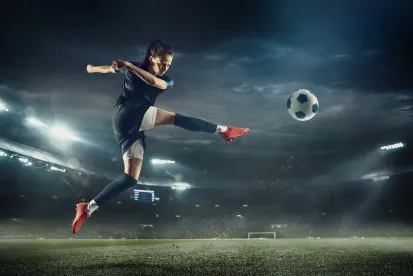Whether an NCAA athlete should be able to profit from their name, image and likeness (NIL) has long been a topic of debate, but until recently it seemed the longstanding NCAA rule prohibiting athletes from NIL compensation would remain the accepted rule. However, beginning this summer, NCAA student-athletes will enter a new landscape of NIL opportunities and college athletics will enter unchartered territory. While the changing of the tide is now inevitable, the question that has yet to be answered is whether this change will come in the form of patchwork legislation by the states, uniform federal legislation or revised NCAA rules. Regardless of where NIL ends up, athletes, colleges and fans are in for a groundbreaking summer.
What Is It?
NCAA athletes are currently prohibited from profiting off their name, image and likeness. The fundamental theory behind this rule has been that this prohibition is necessary to preserve the integrity of college athletics as amateur sports and delineate college athletes from professionals. On the other hand is the position that athletes are an integral part of the popular (and profitable) entertainment product that is college athletics and, as such, they should be able to share in the profits of their marketability. In addition to participation in their sport, student athletes frequently appear at events, on sports television, and in marketing materials and their likeness appears in video games and on merchandise, but due to the current rule the NCAA athlete cannot receive compensation for doing so beyond permissible academic incentives.
This has led to many challenges and presented many hard to answer questions for athletes and institutions alike, such as - Would opening this door to compensation fundamentally change college athletics? How do you balance an individual’s rights of publicity with the desire to protect the amateur nature of college sports? Who is in the best position to determine where the line is? While it will likely be years before the answers to these questions come into focus, the initial framework is being put into place in mere weeks.
What’s Changed?
The NIL debate seems to have come to a head as the Supreme Court weighs the appropriateness of the NCAA’s amateurism rules in Alston v. NCAA. While the sports world anxiously awaits the Supreme Court’s decision (which is expected in the coming weeks), many states have taken the NIL issue into their own hands through the introduction of state legislation.
On July 1, Alabama, Florida, Georgia, Mississippi, and New Mexico have state laws going into effect that will allow NCAA athletes to immediately begin seeking NIL compensation (though the specifics vary state by state). In total, 17 states have laws with effective dates between 2021 and 2025. Wisconsin is currently one of only two states without any NIL proposal introduced in its legislature seemingly hoping for a national solution but also potentially leaving it behind its peers. The July 1 effective date forced the NCAA into action and has also spurred bipartisan action in Congress after a series of bills failed to reach consensus support.
Seeking to avoid a state law patchwork creating an uneven playing field when it comes to recruiting and athlete opportunity, the NCAA Division I Council has announced its intent to act on its NIL legislative proposals at its meetings beginning June 22, 2021.
A previous NCAA policy proposal included provisions allowing student-athletes to use their NIL to promote camps and clinics, private lessons and products and to be paid for their autographs and personal appearances. The policy also allowed student-athletes the opportunity to use professional advice and marketing assistance regarding NIL activities, and professional representation in NIL contract negotiations, with some restrictions. On the institution side, the policy prohibited schools from being involved in the development, operation or promotion of a student-athlete’s business activity, unless the activity is developed as part of a student’s coursework or academic program, and from arranging or securing endorsement opportunities for student-athletes.
Further limitations on NIL opportunities would likely include prohibited use of school logos, prohibited activities such as sports gambling business or other businesses in conflict with the NCAA. Other details such as disclosure of activities and oversight are also expected to be covered in a new NCAA proposal. An NCAA rule will quickly level the playing field for student-athlete NIL opportunity, but interaction between NCAA legislation and new state laws will undoubtedly cause some uneven NIL application and may present as many questions as it does answers.
What’s Next?
The next three months will chart a course for athlete opportunity in the NIL space and will reveal the beginnings of a new NIL landscape, though it will likely be years before the long-term legal environment surrounding NIL takes it final shape. In the meantime, athletes, their families and institutions alike will need education on what this new landscape means for them and how to navigate it successfully.
Institutions will face a sharp learning curve and will need to quickly determine how best to manage the education, enforcement and disclosure pieces of these changes. Institutions will have the challenging task of planning for the effects these changes will have on budgets and the allocation of resources across all sports while remaining nimble enough to respond to the evolution of these regulations. This will likely require more staff and programming for coaches, athletes and their families.
Sports agents and public relations firms will quickly move to secure national and local NIL business opportunities for marketable student-athletes including endorsements, commercials, merchandise sales, autograph signings and monetizing social media accounts, making it imperative that athletes and their families have support in navigating the selection and vetting process. The athlete’s successful management of these opportunities will require careful consideration of legal issues involved, such as NCAA and applicable law compliance, privacy laws, and contract negotiation, as well as wealth management and accounting assistance, something most athletes aren’t introduced to until college graduation or beyond.




 />i
/>i
